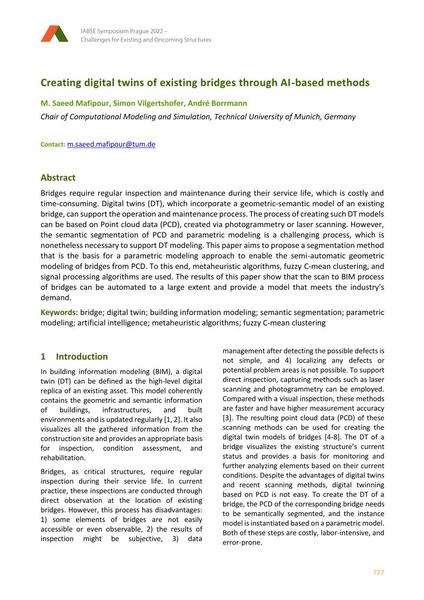Creating digital twins of existing bridges through AI-based methods

|
|
|||||||||||
Bibliografische Angaben
| Autor(en): |
M. Saeed Mafipour
(Chair of Computational Modeling and Simulation, Technical University of Munich, Germany)
Simon Vilgertshofer (Chair of Computational Modeling and Simulation, Technical University of Munich, Germany) André Borrmann (Chair of Computational Modeling and Simulation, Technical University of Munich, Germany) |
||||
|---|---|---|---|---|---|
| Medium: | Tagungsbeitrag | ||||
| Sprache(n): | Englisch | ||||
| Tagung: | IABSE Symposium: Challenges for Existing and Oncoming Structures, Prague, Czech Republic, 25-27 May 2022 | ||||
| Veröffentlicht in: | IABSE Symposium Prague 2022 | ||||
|
|||||
| Seite(n): | 727-734 | ||||
| Anzahl der Seiten (im PDF): | 8 | ||||
| DOI: | 10.2749/prague.2022.0727 | ||||
| Abstrakt: |
Bridges require regular inspection and maintenance during their service life, which is costly and time-consuming. Digital twins (DT), which incorporate a geometric-semantic model of an existing bridge, can support the operation and maintenance process. The process of creating such DT models can be based on Point cloud data (PCD), created via photogrammetry or laser scanning. However, the semantic segmentation of PCD and parametric modeling is a challenging process, which is nonetheless necessary to support DT modeling. This paper aims to propose a segmentation method that is the basis for a parametric modeling approach to enable the semi-automatic geometric modeling of bridges from PCD. To this end, metaheuristic algorithms, fuzzy C-mean clustering, and signal processing algorithms are used. The results of this paper show that the scan to BIM process of bridges can be automated to a large extent and provide a model that meets the industry’s demand. |
||||
| Stichwörter: |
Brücke Building Information Modeling Fuzzy-C-Mittelwert-Clustering
|
||||
| Copyright: | © 2022 International Association for Bridge and Structural Engineering (IABSE) | ||||
| Lizenz: | Die Urheberrechte (Copyright) für dieses Werk sind rechtlich geschützt. Es darf nicht ohne die Zustimmung des Autors/der Autorin oder Rechteinhabers/-in weiter benutzt werden. |
||||
